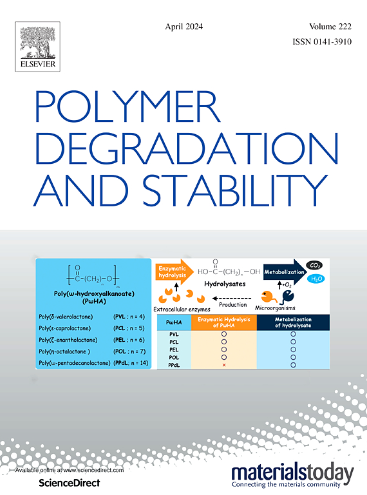涤棉混纺织物的溶解沉淀预处理和酶解聚合闭环回收
IF 7.4
2区 化学
Q1 POLYMER SCIENCE
引用次数: 0
摘要
涤棉混纺织物各组分的化学性质不同,其结构相互交织,给废旧涤棉混纺织物的回收利用带来了挑战。本文通过室温溶解沉淀预处理和酶解聚合将多氯联苯降解为单体。聚酯选择性地从PCB中溶解分离,然后在抗溶剂中沉淀。考察了溶解PET浓度对沉淀PET回收率、粒度和结晶度的影响。沉淀的PET具有纳米级尺寸和7.8%的低结晶度,显著加速了酶解聚合。从PCB中分离的棉纤维也被酶解聚合成葡萄糖。最后,通过这种方法成功地转换了具有不同成分比和颜色的实际pcb。本研究为PCB废弃物的闭环回收提供了一种很有前景的方法。本文章由计算机程序翻译,如有差异,请以英文原文为准。
Closed-loop recycling of polyester-cotton blended fabrics through dissolution-precipitation pretreatment and enzymatic depolymerization
Recycling of waste polyester-cotton blended fabrics (PCB) is confronted with challenges due to the different chemical properties of each component and their intertwined structure. Herein, PCBs were degraded into monomers through room-temperature dissolution-precipitation pretreatment and enzymatic depolymerization. Polyester was selectively dissolved and separated from PCB and then precipitated in anti-solvent. The influence of the dissolved PET concentration on the recovery, particle size, and crystallinity of precipitated PET was investigated. The precipitated PET exhibited nanometer size and low crystallinity of 7.8 %, which significantly accelerated the enzymatic depolymerization. The separated cotton fibers from PCB were also enzymatically depolymerized into glucose. At last, real-world PCBs with different component ratios and colors were successfully converted through this approach. This research provides a promising method for closed-loop recycling of PCB wastes.
求助全文
通过发布文献求助,成功后即可免费获取论文全文。
去求助
来源期刊

Polymer Degradation and Stability
化学-高分子科学
CiteScore
10.10
自引率
10.20%
发文量
325
审稿时长
23 days
期刊介绍:
Polymer Degradation and Stability deals with the degradation reactions and their control which are a major preoccupation of practitioners of the many and diverse aspects of modern polymer technology.
Deteriorative reactions occur during processing, when polymers are subjected to heat, oxygen and mechanical stress, and during the useful life of the materials when oxygen and sunlight are the most important degradative agencies. In more specialised applications, degradation may be induced by high energy radiation, ozone, atmospheric pollutants, mechanical stress, biological action, hydrolysis and many other influences. The mechanisms of these reactions and stabilisation processes must be understood if the technology and application of polymers are to continue to advance. The reporting of investigations of this kind is therefore a major function of this journal.
However there are also new developments in polymer technology in which degradation processes find positive applications. For example, photodegradable plastics are now available, the recycling of polymeric products will become increasingly important, degradation and combustion studies are involved in the definition of the fire hazards which are associated with polymeric materials and the microelectronics industry is vitally dependent upon polymer degradation in the manufacture of its circuitry. Polymer properties may also be improved by processes like curing and grafting, the chemistry of which can be closely related to that which causes physical deterioration in other circumstances.
 求助内容:
求助内容: 应助结果提醒方式:
应助结果提醒方式:


